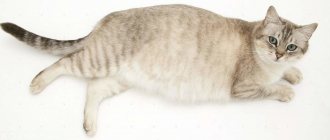Merle (merle color) is characteristic of many officially recognized breeds and is allowed in their standard. The merle color is incredibly popular among dog lovers and it is not surprising - such dogs catch the eye and enjoy the attention of people around them.
The merle color is one of the main colors of such breeds as: Australian Shepherd, Miniature American Shepherd (Mini Aussie), Border Collie, Beauceron, Welsh Corgi Cardigan, Collie, Dachshund, Great Dane, Mudi, Pyrenean Shepherd, Sheltie, Norwegian Dunker, Dachshund .
Due to the enormous popularity and high demand for merle puppies, merle began to appear in breeds where it had never been recognized and was considered disqualifying. These are, for example: poodle, chihuahua, French bulldog, English bulldog, Spitz, pit bull, bull terrier, cocker spaniel and others.
Merle itself is safe and the health of dogs does not depend on color. The fact that merle dogs are completely sick is a common myth that was invented by people who are far from understanding the relationship between color and its effect on health. Of course, in the hands of unscrupulous breeders, the merle color is a dangerous tool (read more about the double merle color), but this article is not about that.
What is merle color in dogs?
Marble coloring is a weakening of the main color in certain areas of the coat. From the outside it looks like a lot of chaotic light spots on top of a darker tone. A symmetrical arrangement is rare.
In addition to the fur, the unusual colors affect the eyes. Because of this, heterochromia develops - uneven color of the iris. The eyes become multi-colored or speckled.
Marble on wool is very rare. In many breeds it is equated to marriage, citing a possible danger to the health of the animal.
Price
Blue color is quite rare for a Pomeranian. That's why puppies are more valuable. Blue merle is a gray with varying shades. Prices for animals can reach several thousand dollars.
Merle Spitz puppy
Since the breed is not officially standardized, the merle color is considered a defect, but despite this, due to its rarity, it is highly valued by breeders and owners.
You can buy Merle Spitz in the following nurseries:
- “Tricksy baby (Kherson)”;
- "Merli Sa Tise";
- "From Mrs. Yanina."
Buy such a dog from nurseries to obtain information about the genotype of the parents. This way you will be confident that you are taking a healthy and full-fledged Pomeranian into your home.
How is merle made?
The dominant M gene, which causes albinism, is responsible for the appearance of merle. If it is present, the dog will always be spotted. The M gene blocks pigmentation, turning a solid color into a “diluted” one.
When breeding, marbled quadrupeds are crossed with tricolored ones. The latter do not have the M gene in their DNA. Their color is uniform, but consists of 3 colors: the main one and 2 additional ones. Mating these animals with each other is not dangerous. One half of the puppies obtained from them acquire spotted fur, and the second - tricolor.
Deviations are observed when two marbled parents are mated. In this case, 25% of their offspring inherit 2 dominant M genes at once, another 25% are born tricolored, and the remaining 50% are spotted, but with only one M gene.
Genetics
To make it clearer, let's look at everything in more detail. Tricolor dogs do not carry the merle gene - let's call them mm. Merle dogs, let's call them Mm, carry the merle gene and pass it on to their offspring. When mating a tricolor dog with a marble dog, all puppies will be born healthy (mm or Mm).
Merle + tricolor mating
Mm + mm
50% of puppies are merle color (Mm) 50% of puppies are tricolor color (mm)
there is no danger of getting double merle (MM) puppies
Standard mating (without the risk of getting sick offspring)
When two merle-colored dogs are mated, some of the offspring will be tricolor (mm) or merle (Mm), and some of the offspring may be double merle (MM). Such mating is a huge risk for the breeder to get sick offspring.
Merle + merle mating
Mm + Mm
50% of puppies are merle color (Mm) 25% of puppies are tricolor color (mm) 25% of puppies are double merle color (MM)
danger of getting double merle (MM) puppies
Dangerous mating (with the risk of getting sick offspring)
Merle color varieties
Depending on the main color, the following types of marble are distinguished:
- blue merle (blue) - lightening black to gray;
- red merle (red) - lightening red to cream or light brown;
- sable merle (sable) - a combination of sable color and blue merle (immediately after birth, the puppy appears almost white, but darkens as it grows up);
- cryptic merle (hidden) - resembles a tricolor; the presence of the M gene can only be indicated by a tiny silver speck (most often determined only by genetic analysis);
- white merle (double or double) - most of the body is painted white, spots are practically or completely absent.
The last type is the most dangerous. This is what is obtained when mating 2 spotted dogs. It is distinguished from the plain white color by the absence of pigmentation on the skin. Double merle puppies are born with pinkish lips, nose and eyelid rims. While in truly snow-white dogs (for example, Samoyeds), these areas are always painted black.
List of genetic problems associated with the M gene
Breeds that have the mutation:
- dachshund;
- Great Dane;
- pug;
- French Bulldog;
- coolie;
- Australian Shepherd;
- long-haired and short-haired Scottish Shepherd;
- corgi cardigan;
- Border Collie;
- leopard dog.
Leopard Hound
When a breeder is not sure whether his pet is a merle, it is recommended to have a test done. Homozygous individuals (MM) are sometimes born:
- with deformity or complete absence of eyes or ears;
- partially or completely deaf (54.6% of MM-homozygotes and 36.8% of MM-heterozygotes were found with hearing problems of varying severity - from mild to complete deafness);
- barren;
- predisposed to eyeball abnormalities (flattened fundus, twilight blindness, risk of developing cataracts).
Dominant homozygotes arise only from the combination of two individuals - carriers of the M gene. In many European countries, their mating has been banned.
Why is this color considered dangerous?
When the M gene is inherited from both parents, puppies often die while still inside the mother's womb. If they manage to avoid death at the embryonic stage, then the following disorders await them at birth:
- atrophy of the ears or eyes;
- heart diseases;
- low fertility or infertility;
- ophthalmological pathologies (cataracts, night blindness, flattening of the fundus);
- mental disorders, including a tendency to increased aggression.
When breeding spotted animals, it is important to exclude the presence of hidden merle. To do this you need to take a genetic test.
The effect of the merle gene on the health of Chihuahuas
Representatives of Merle Chihuahuas have recently appeared in some American nurseries. This coloration has never been part of the species' history. According to geneticists, Chihuahuas were given the merle color of a dachshund or sheltie.
In addition to the fact that the breed is susceptible to joint diseases, marbled species, in addition to exotic coloring, also have their own pathologies (even with a single Mm):
- lens dislocation and corneal dystrophy;
- high mortality of newborn puppies;
- high probability of giving birth to crippled puppies (without an eye or ear);
- birth of infertile animals;
- gross anomalies of the sensory organs;
- sperm deficiency.
You should provide your pet with a calm walk without straining the joints, and beware of overheating and cooling. In hot weather, allow yourself to drink more water.
What breeds are allowed to have merle coloring?
In most cases, merle-colored dogs are different breeds of shepherd dogs. For other pets it is usually prohibited.
Australian Shepherd (Aussie)
Blue merle Aussies have black eye rims, while merle red Aussies have brown eye rims. The standard also allows black and red wool with a small amount of white areas.
Friendly Australian Shepherds easily get along with cats, hamsters and even geese. To maintain good health, activity is very important for them, so they enjoy playing with children and accompanying their owners on hikes.
Border Collie
The Border Collie standard allows for any variety of merle coloring. The only restriction is the ban on the predominance of white color.
Marbled Border Collies are often confused with Aussies. In fact, this color is rare for them, and the most common coat color is black and white.
Representatives of this breed are the smartest dogs in the world. They understand the meaning of many human words and even learn the names of toys.
Scottish Sheepdog (Collie)
The coat of Scottish Shepherds comes in only 3 types: blue merle, tricolor and sable. The peak of popularity of these charming dogs occurred during the Soviet era.
Collies love to talk, so those who like silence should choose someone calmer. There is no point in weaning them off barking, since this is how they show their love and share their experiences.
Shetland Sheepdog (Sheltie)
The breed is characterized by the following coat colors: blue merle, tricolor, sable, black-brown and black-and-white. The coat itself is soft and thick. Long hairs on the body form a characteristic mane and “pants”.
The Sheltie is almost 2 times smaller than the Collie. Due to their inexhaustible supply of energy, they need regular physical exercise.
Welsh Corgi Cardigan
This adorable little guy is also a shepherd. Unlike the “loaf-shaped” Pembroke, the Cardigan standard is less picky about color. It accepts any variety, including blue merle and brindle.
Due to the popularity of Pembrokes, Cardigans almost disappeared, but in 2016 their numbers were restored. These pets are discreet and docile. They are unfamiliar with the feeling of jealousy, so they easily get along in the same territory with other pets.
Dachshund
Dachshunds come in red, black and brown. The merle on their coat can be combined with any of the listed colors.
Due to their too long body and short legs, dachshunds cannot stand on their hind legs and jump from heights. To sleep together with such pets, you will have to build a ladder so that they can safely climb onto the bed.
German dog
These stately aristocrats have dense and short fur. The standard allows for its coloring in merle, black, blue, fawn and brindle.
Great Danes are the tallest dogs in the world. Keeping them in an apartment is possible only because of their calm nature. But even in this case, the size of the accessible area should be at least 3, and preferably 4 rooms.
The nuances of owning and training a marbled Chihuahua
The Chihuahua is a very small breed. However, the character of the breed’s representatives is not entirely in harmony with the small body dimensions. These are brave and smart dogs that are not afraid of challenges and often face much larger dogs.
Dogs of this breed are usually quite distrustful of strangers, patrolling their territory and loudly warning in case of an intruder. These little ones are very smart, but if you neglect their upbringing, they turn into very barking and disobedient pets. In addition, the merle color of a Chihuahua arouses interest among passers-by, which can frighten the baby. If your friend's anxiety is excessive, it may be best to take a course with a trainer to restore confidence.
Marbled Chihuahua is prohibited
It is better to teach using encouraging methods, using rewards and gratitude. If your pet doesn't do something, you shouldn't use harsh punishments. During the day, 3-5 workouts of 10-15 minutes are introduced. For correctly executed commands, they are given a reward in the form of their favorite food or treat.
Which breeds are prohibited from having merle coloring?
In the breeds listed above, the presence of spots is rarely accompanied by disturbances. In all other cases, everything is much sadder.
Experiments with other dogs were less successful and resulted in many health problems. Because of this, marble was included in their standards as a reason for disqualification.
Pembroke Welsh Corgi
Unlike cardigans, the main color of Pembrokes is red. Sable and black and tan are also acceptable. Merle is not allowed in their standard.
Cheerful Pembrokes have a strong need for human attention. They cannot be kept outside, much less on a leash.
Chihuahua
All colors of Chihuahuas are allowed except merle. Thanks to their compact size, these babies can be kept even in a tiny studio apartment.
Chihuahuas are active, playful and fearless. They can easily bark at a larger dog, ignoring the difference in weight.
French Bulldog
The smooth and shiny coat of French bulldogs lacks undercoat and cannot withstand severe frosts. It comes in white, brindle, beige, fawn and black. Merle is prohibited by the standard, and blue is recognized only by some cynological organizations.
Bulldogs often drool, snore, shed heavily, and suffer from flatulence. Because of this, they are not suitable for clean people and allergy sufferers.
American Cocker Spaniel
Merle is not allowed in American Cocker Spaniels, but all solid colors and colors mixed with white are allowed. The presence of tan marks is possible only on certain parts of the body: cheekbones, paws, the area under the tail, under the eyes, on the inside of the ears and on the chest.
American cockers love to manipulate, but are very vulnerable. A raised tone or dissatisfied intonation can seriously offend them.
Pomeranian Spitz
The FCI does not recognize merle in Pomeranians due to too few individuals. Their number is only a couple of hundred. All other Spitz dogs have 1 of the following 10 colors:
- blue;
- cream;
- sable;
- chocolate;
- white;
- black;
- ginger;
- bicolor;
- black and blue with tan.
Fluffy “bells” are very sensitive to sounds. They bark at any suspicious noise, which often irritates their neighbors.
Yorkshire Terrier
The color of the Yorkie's shiny and silky coat depends on its location. On the head and chest it is red-brown, on the paws it is golden, from the withers to the base of the tail it is silver-blue, and at the very tip of the tail it is dark blue. Merle is prohibited by the standard.
Like the Chihuahua, the Yorkie is suitable for keeping in small apartments. Future owners should know that he is very picky about food.
American Pit Bull Terrier (Pitbull)
The standard allows any existing shades. Unlike most breeds, even the presence of white spots is not prohibited. The only exception is marble.
Pit bulls are good at canine sports and know how to keep their emotions under control. It is difficult to anger them, but with outright provocation they can inflict serious injuries on the offender. For this reason, breeding American Pit Bull Terriers is prohibited in many EU countries.
Do you like the article? 261
Origin story
The first attempts by breeders to complement the color range of Pomeranians began back in the 1800s.
Over time, in addition to tan, sable and other unusual shades, a new color appeared on the scene - merle. The Merle Spitz is a recently bred species through crossbreeding, which is considered a defect according to the RKF. All over the world, such dogs are not allowed to exhibit, but in America they are bred and officially recognized as the standard. The merle color was developed by crossing a Pomeranian and a merle sheltie.
Spitz merle
Blue merle (blue merle) in adulthood is similar to streaked. The breed is small in number and is not yet one of the most expensive. Bred in Germany by breeder, biologist and geneticist, Professor Kirsten Sanche-Mayer in the Vom Klisterbach nursery. Recognized and registered for the first time by the German club IHR eV
Deafness
The most common problem in double merle dogs is congenital deafness. It is often said that dogs with white ears will be deaf, but this is not always the case. In fact, the cause of congenital deafness is not pigment in the outer ear, but tiny hairs in the inner ear that we cannot see. If there is no pigment on them, then during the first three weeks of the puppy’s life, the nerve endings die and the animal remains deaf for life.
Deafness in such dogs can be one-sided (hearing loss) or two-sided (complete). Dogs who are hard of hearing can hear either in one ear or at certain frequencies, but not at the normal volume of speech. Completely deaf dogs remain so for the rest of their lives and their owners communicate with them using gestures.
The double merle color is not always necessarily associated with deafness, and there are cases where dogs have normal hearing. Therefore, if such a dog suddenly becomes deaf at a later age, the reason may be, for example, infection or age, but is not related to color.
If with complete deafness everything is obvious - the dog does not respond to a name or to any sounds in general, then owners of partially hearing dogs do not always realize that their pet has hearing problems. The only definitive way to determine whether a dog is deaf or hard of hearing is through BAER testing.
Host reviews
A restless, cheerful dog. Runs quickly around the apartment and on the street. Thanks to her, I fell in love with long walks.
My wife bought the dog without my knowledge. She said it was just a Pomeranian. When I went online, I was even upset that the color was not considered a standard. But now, walking down the street, I always meet admiring glances. I'm lucky with my health, but my eyes are different colors.
Got a dog for my birthday. At first I was happy, but then it turned out that the puppy had sore ears and couldn’t see well. Six months have passed and I can’t live without him. He somehow understands me on an intuitive level, what I want from him, where I am and distinguishes between objects. I'm proud of my baby.
Disqualifying faults
RKF admitted a number of serious violations that will lead to disqualification from the exhibition event. These include spots on the coat of any color other than white. The presence of white marks on the tips of the legs or chest is not a fundamental reason to disqualify an animal.
An equally serious violation is a black nose in any type of Spitz except chocolate. The brown one may have a nose that matches the color of the fur.
If the exhibition is held in winter, a lighter nose on an orange, beige or cream Spitz is not considered a disqualifying fault. This is due to the fact that in winter their nose always becomes lighter.











